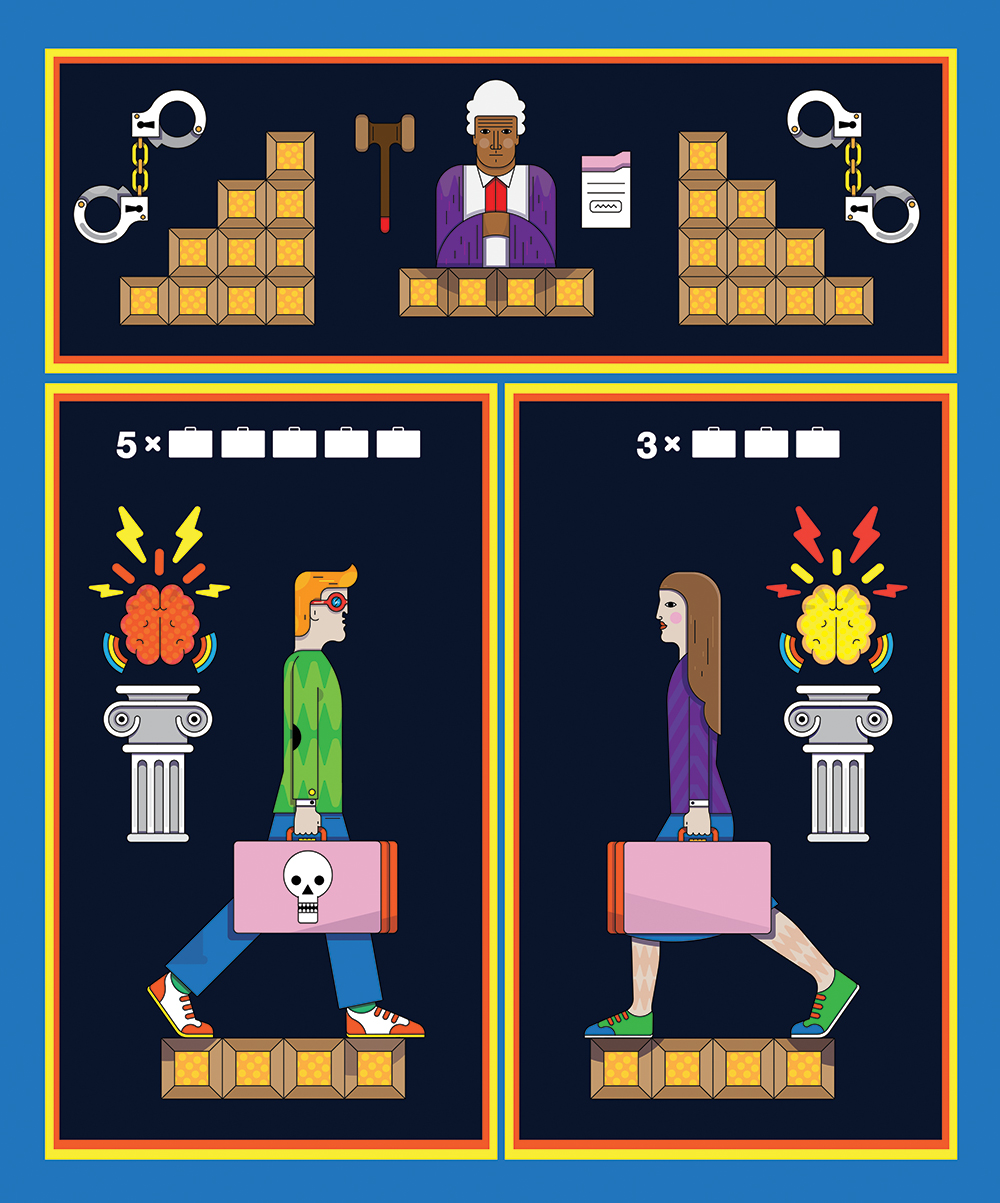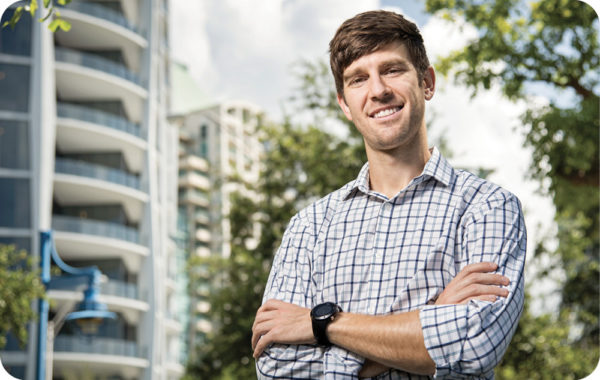By Michael Blanding

Imagine you are paid to carry a briefcase through a checkpoint that may or may not be guarded. In one scenario, you know the case contains illegal contraband, and if you get caught you will be arrested. In another scenario, you choose one of three cases, only one of which contains contraband, while the others are safe. How do the different risks of carrying contraband affect your choices?
These two scenarios demonstrate the difference between a “knowing” and “reckless” state of mind, says Owen Jones, the Glenn M. Weaver, M.D., and Mary Ellen Weaver Professor of Law, Brain and Behavior and professor of biological sciences. Jones and colleagues designed the briefcase experiment to examine what, if anything, distinguishes these two mental states in the brain. While the distinction has long been a key determinant of criminal justice, and was incorporated into the criminal statutes of most states more than 50 years ago, no one has ever tested it scientifically to see whether or not it actually exists.
As director of the MacArthur Foundation Research Network on Law and Neuroscience—an interdisciplinary initiative based at Vanderbilt Law School and supported by $7.6 million in grants from the John D. and Catherine T. MacArthur Foundation—Jones has spent more than a decade exploring the assumptions our legal system makes about how criminals, judges and juries think. Ultimately, the network’s experiments aim to explore both the promise and the limitations of using neuroscience—either in courtrooms or for legal policy reform—to inform questions relevant to criminal justice. (Read a recent feature article in the ABA Journal about the network.)
For instance, the law distinguishes between four different criminal states of mind (otherwise known by the Latin term mens rea) with varying degrees of culpability: purposeful, knowing, reckless and negligent. The first and last are relatively straightforward. When you shoot someone purposefully, you mean to kill them. When you toss a loaded gun onto the couch and it shoots someone in the room, you have been negligent.
The middle two states, however, are more of a gray area in terms of intent. Knowingly committing a crime is like shooting through someone, during a hunt, to kill the rhinoceros standing behind him. “It might not have been my purpose to kill the person in the way, but I still know he’s going to die,” Jones explains. On the other hand, reckless behavior is like shooting a gun in the air while in a crowd: “The bullet is not guaranteed to hit somebody,” he says, “but there’s a substantial risk that it might.”
When it comes to punishment, the law considers the two scenarios very differently. “In Colorado, for example, for the same homicide, a knowing frame of mind or a reckless frame of mind can be the difference between 48 years in prison and none,” Jones explains.
Studies by Jones and colleagues of mock jurors have shown that the average subject has difficulty distinguishing between the two. “It’s practically flipping a coin on whether they get it right,” he says. That challenge has added fuel to a vigorous debate among legal scholars and policymakers on whether the distinction is valid, and whether it should even remain part of our criminal law.

That is where the briefcase experiment comes in. Jones and colleagues from Yale University, University of Pennsylvania, Virginia Tech and other institutions presented 40 participants with dozens of varying contraband case scenarios while they were inside an fMRI—or functional (rather than structural) magnetic resonance imaging scanner—which was tasked to measure brain activities by monitoring changes in blood flow.
They found that as participants played through the scenarios on a computer, and when they acquired relevant information in a particular sequence, their brains showed clear differences in patterns of activity when they knew they were definitely carrying contraband versus when they merely suspected it. What’s more, the differences varied according to how reckless their choice was, given the varying risks involved. If they were carrying one case out of three, the brain activity was different than if they were carrying one out of five.
“There were consistent differences between these two brain states neurologically,” Jones says. “We developed an algorithm that could predict quite accurately and reliably whether or not someone was in a reckless frame of mind or a knowing state of mind.”
While such a tool is not intended to be used forensically to determine someone’s state of mind after the fact, he says, it examined and now gives credence to the legal distinction already in place, showing that “knowing” and “reckless” are indeed separate states of mind. That outcome lends some empirical support to the practice of punishing them differently.
The combination of neuroscience and law—or “neurolaw” as some call it—has been gaining traction in courtrooms in recent years, with lawyers increasingly introducing their clients’ brain scans into evidence to show, for example, a diminished mental capacity that might make them less culpable for crimes. Jones and his colleagues have used the burgeoning field to ask deeper questions about the criminal justice system itself.
WORK ACROSS DISCIPLINES—AND CAMPUSES
Jones has been interested in behavioral biology since childhood, when he began reading studies of animal behavior. He wrote his first paper combining law and behavioral biology for one of his undergraduate biology classes at Amherst College. By the time he was a law student at Yale, he was interested in expanding this interdisciplinary perspective.
“The legal system doesn’t really think of itself as having a behavioral model, but it inherently does,” he says. “And behavior comes from the brain, in line with evolutionary and neuroscientific principles.” Whether it is punishing crimes with prison time or creating regulations for operating vehicles, he says, “whatever the legal system tries to accomplish, it achieves by inspiring some sort of behavioral change in people.”
After law school Jones clerked for a U.S. district court judge and practiced at Washington, D.C., law firm Covington & Burling, while continuing to follow developments in behavioral biology. Those developments later included transformative technologies for discovering human brain activities. Around the time Jones was recruited to Vanderbilt in 2004, the university was opening a $27 million neuroimaging facility that allowed him, partnered with neuroscience colleagues, to conduct more advanced experiments.
Jones credits Vanderbilt’s neuroscience faculty—particularly René Marois, professor and chair of the Department of Psychology and professor of radiology and radiological sciences; Jeff Schall, E. Bronson Ingram Professor of Neuroscience and professor of psychology, ophthalmology and visual sciences; David Zald, Cornelius Vanderbilt Professor of Psychology and professor of psychiatry and behavioral sciences; and John Gore, University Professor of Radiology and Radiological Sciences and holder of the Hertha Ramsey Cress Chair in Medicine, and their lab teams—with welcoming and fostering these trans-institutional experiments, which further solidified and expanded his interests. In fact, Jones and Schall, along with University of Minnesota’s Francis Shen, would go on to co-author in 2014 what is considered the definitive reference book on the topic, Law and Neuroscience (Aspen Casebook).
“We developed an algorithm that could predict quite accurately and reliably whether or not someone was in a reckless frame of mind or a knowing state of mind.”
After Jones had been at Vanderbilt for a few years, a colleague, Stanford behavioral biologist Robert Sapolsky, proposed an ambitious project to the MacArthur Foundation that would completely reimagine the criminal justice system based on a modern neuroscientific perspective. The foundation tapped a small group of legal and neuroscience scholars, including Jones, to consider and develop a narrower proposal to examine several distinct areas in which neuroscience and legal issues intersect. Jones was among the co-directors of what ultimately became the nationwide exploratory Law and Neuroscience Project, which the foundation later asked him to direct through its remaining term.
Subsequently, Jones and a team of top scholars he assembled from Yale, Columbia, Stanford, Penn, University of Virginia and other institutions developed a 400-page grant proposal to create a new research network focused on a half-dozen neurolaw project areas. The foundation funded that proposal, which has served as the network’s road map since 2011.
“Owen Jones is that rare combination of a capable leader and a pioneering scholar whose work is pushing the study of law into uncharted territory,” says Chris Guthrie, dean of Vanderbilt Law School and John Wade–Kent Syverud Professor of Law. “His work has profound implications for how we understand the relationship between law and human behavior and how we approach criminal law and policy specifically.”
In addition to the aforementioned briefcase experiment that a large network team organized to test knowledge and recklessness, other working groups Jones established within the network have conducted a variety of studies addressing prominent problems at the intersection of law and science.
For example, using fMRI to scan hundreds of juveniles and young adults as they made decisions, one group identified circumstances under which a young adult’s brain activities and resulting behavior were more like a juvenile’s and other circumstances under which they were more like an older adult’s. These findings could have implications for the prospects of reform in juvenile justice and how we perceive adolescent-to-adult transition.
Another working group paired fMRI with machine-learning algorithms to see whether brain scanning could reliably detect when a subject looking at many photographs was seeing one from his or her own life. Surprising everyone, the scanning was accurate more than 90 percent of the time, at least under laboratory conditions, indicating that this technology could theoretically (and troublingly) probe the memories of defendants, suspects or witnesses.
Meanwhile, another group used scanning—at Vanderbilt, Harvard and Emory—to unpack the multiple regions, activities and interactions in the brain that are involved in deciding whether to punish someone and, if so, to what degree. Among its findings the group illuminated not only how rational and emotional regions of the brain interact—specifically how the former can sometimes override the latter—but also how the use of a repetitive magnetic pulse can disrupt (temporarily and safely) an area known as the right dorsolateral prefrontal cortex, changing the degree to which subjects punished hypothetical criminals while leaving unchanged the degree to which the same subjects blamed the criminals.
Overall, during the past nine years since the network began, it has contributed significantly to the growing field of neurolaw, with some 85 published papers, about half of them conceptual and half the results of hands-on fMRI research. Even more significant, however, Jones points to about 600 publication citations in the field during just the past five years, showing the effect that the massive investment of the network has had on seeding and inspiring the field as a whole.
“That’s very exciting,” says Jones, “because it means we’ve done exactly what we hoped to do, which was to make this interdisciplinary effort and intersection thrive.”
GRAY MATTER: RECENT GRADUATE’S NEUROSCIENCE RESEARCH QUESTIONS CERTAIN RULES OF EVIDENCE IN THE COURTROOM
In addition to housing the MacArthur Foundation Research Network on Law and Neuroscience, Vanderbilt Law School also launched the nation’s first integrated joint law and neuroscience J.D./Ph.D. program in 2011. One of its first students, Chris Sundby, JD’20, PhD’20, who successfully defended his dissertation in the spring and graduated in May, hopes to make a practical impact on the rules governing legal practice.
“The goal of all my projects is to build a bridge from basic neuroscience to the on-the-ground legal field,” Sundby says, “and to minimize the extrapolation that legal experts need to understand the impact of neuroscience research.”
His most recent project explores the embedded psychological assumptions in federal evidentiary rules, which control what evidence can and cannot be admitted into the courtroom during trial. One rule, for example, controls hearsay evidence—secondhand testimony reported by another witness.

“We have great faith in a jury being able to detect deceit and testimonial errors when an actual witness is on the stand,” Sundby says. “But when someone else told the witness that information, the jury can’t assess the actual observer’s truthfulness, nor is that person subject to cross-examination.”
Through the years courts have provided some exceptions to the hearsay rule, when witnesses are presumed to be truthful, including one called “present sense impression” (PSI), in which the other person testified to the witness while actually watching a crime take place or “substantially contemporaneous” to the time it occurred.
“The law assumes you don’t have time to lie,” Sundby says, “so you’re just going to be truthful.” In some cases, courts have allowed hearsay testimony 30 seconds, or even up to 30 minutes, after the crime occurred.
He created an experiment to determine the validity of PSI by using electroencephalogram technology to measure electric signals in the brains of participants asked to lie or tell the truth—either contemporaneously or after a delay—about the color of a square they see on a screen. His results showed, among other things, that people are able to lie about the color within just half a second and use different cognitive strategies when lying in the moment versus after a delay, calling into question the core assumption of the PSI rule.
Sundby also is expanding his research to examine other rules of evidence. Another hearsay exception called “excited utterance,” for example, assumes that someone will tell the truth when in a heightened emotional state. “The idea is that you just saw a murder and it understandably freaked you out, so you can’t lie,” he says. “That strikes me as very, very dubious.”
Sundby hopes his research someday will influence policymakers to consider changes to the rules that would better reflect what is actually happening in the gray matter of witnesses and jury members as they sit in the courtroom.
“As fascinating as it is to conduct research, one very important part of this field is that it has the potential to affect on-the-ground reality,” he says. “That’s one reason I decided to focus on procedural rules. I believe this type of research in particular can have an impact and help improve the efficacy and accuracy of the legal system.”
Michael Blanding is an award-winning Boston-based journalist whose work has appeared in The New York Times, Wired, Slate, The Nation, and The Boston Globe Magazine. Currently, he is a senior fellow at the Schuster Institute for Investigative Journalism at Brandeis University.